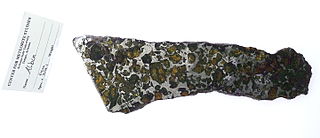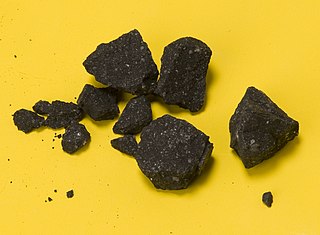 W
WAlbin meteorite is a meteorite found in Laramie County, Wyoming, United States. It is a pallasite of 83 pounds (38 kg) and is characterized by very clear crystals of olivine up to 1.5 inches (3.8 cm) across.
 W
WAllegan is a type 5 H chondrite meteorite that landed in Michigan on July 10, 1899. Allegan weighed around fifty pounds after its landing. As of 1964, it was one of only seven known meteorites to land in Michigan.
 W
WThe Bear Creek meteorite, formerly known as the Colorado meteorite, is an octahedrite meteorite that was found in 1866 in Jefferson County, Colorado, United States. It has a mass of 226.7 kg (500 lb) and average dimensions of 350 mm × 250 mm × 11 mm.
 W
WBrenham is a pallasite meteorite found near Haviland, a small town in Kiowa County, Kansas, United States. Pallasites are a type of stony–iron meteorite that when cut and polished show yellowish olivine (peridot) crystals.
 W
WBurnwell is an unincorporated community located in Pike County, Kentucky, United States.
 W
WThe Canyon Diablo meteorites include the many fragments of the asteroid that created Barringer Crater, Arizona, United States. Meteorites have been found around the crater rim, and are named for nearby Canyon Diablo, which lies about three to four miles west of the crater.
 W
WThe National Museum of Brazil collections include an exhibition of meteorites discovered in Brazil and other countries.
 W
WThe Eagle Station meteorite is a pallasite and type specimen of the Eagle Station group.
 W
WFaith is a chondrite meteorite that was found in 1952 in Perkins County, South Dakota, United States. It has a mass of 105 kg (231 lb).
 W
WThe Goose Lake meteorite is a meteorite that was found at Goose Lake in the United States by two hunters from Oakland, California on October 13, 1938.
 W
WThe Grant Meteorite is a meteorite that was discovered in the Zuni Mountains, about 45 miles (72 km) south of Grants, New Mexico. It was unearthed in 1929 although the date of its original groundfall is unknown.
 W
WHomestead is a L5 meteorite fallen in 1875 in Iowa, United States.
 W
WJohnstown is a Home Rule Municipality in Weld and Larimer counties in the U.S. state of Colorado. The population was 9,887 at the 2010 United States Census.
 W
WNorton County is an Aubrite meteorite that fell in 1948 in Kansas, United States.
 W
WThe Novato meteorite is an ordinary chondrite which entered the earth's atmosphere and broke up over Northern California at 19:44 Pacific Time on 17 October 2012. The fireball created sonic booms and fragmented. The meteoroid was about 35 centimeters (14 in) across.
 W
WThe Old Woman Meteorite is the largest meteorite found in California and the second largest in the United States. It was discovered in the Old Woman Mountains in southern California in late 1975. It is 38 inches (970 mm) long, 34 inches (860 mm) high, and 30 inches (760 mm) wide. The meteorite is mostly composed of iron, but also contains nickel, as well as small amounts of chromium, cobalt, phosphorus, and sulfur.
 W
WThe Paragould Meteorite at 41 inches (1,000 mm) by 24 inches (610 mm) by 16 inches (410 mm) and weighing 370 kilograms (820 lb) is the second largest witnessed meteorite fall ever recovered in North America and the largest stony meteorite chondrite. It fell to Earth at approximately 4:08 a.m. on February 17, 1930.
 W
WPark Forest is an L5 chondrite meteorite that fell on 26 March 2003 in Illinois, United States.
 W
WThe Peekskill meteorite is among the most historic meteorite events on record. Sixteen separate video recordings document the meteorite burning through the Earth's atmosphere, whereupon it struck a parked car in Peekskill, New York. The Peekskill meteorite is an H6 monomict breccia; its filigreed texture is the result of the shocking and heating following the impact of two asteroids in outer space. The meteorite is of the stony variety and approximately 20% of its mass is tiny flakes of nickel-iron. When it struck Earth, the meteorite weighed 26 pounds (12 kg) and measured one foot in diameter. The Peekskill meteorite is estimated to be 4.4 billion years old.
 W
WThe Richardton meteorite is a 90 kilograms (200 lb) H5 Ordinary chondrite that was seen to fall at 21:48 on 30 June 1918 between Mott, North Dakota and Richardton, North Dakota, United States.
 W
WThe Sutter's Mill meteorite is a carbonaceous chondrite which entered the Earth's atmosphere and broke up at about 07:51 Pacific Time on April 22, 2012, with fragments landing in the United States. The name comes from the Sutter's Mill, a California Gold Rush site, near which some pieces were recovered. Meteor astronomer Peter Jenniskens assigned Sutter's Mill (SM) numbers to each meteorite, with the documented find location preserving information about where a given meteorite was located in the impacting meteoroid. As of May 2014, 79 fragments had been publicly documented with a find location. The largest (SM53) weighs 205 grams (7.2 oz), and the second largest (SM50) weighs 42 grams (1.5 oz).
 W
WThe Sylacauga meteorite fell on November 30, 1954, at 12:46 local time in Oak Grove, Alabama, near Sylacauga. It is commonly called the Hodges meteorite because a fragment of it struck Ann Elizabeth Fowler Hodges (1920–1972).
 W
WThe Weston meteorite is an H4 ordinary chondrite meteorite which fell to earth above the town of Weston, Connecticut on the morning of December 14, 1807.
 W
WThe Willamette Meteorite, officially named Willamette and originally known as Tomanowos by the Clackamas Chinook Native American tribe is an iron-nickel meteorite found in the U.S. state of Oregon. It is the largest meteorite found in North America and the sixth largest in the world. There was no impact crater at the discovery site; researchers believe the meteorite landed in what is now Canada or Montana, and was transported as a glacial erratic to the Willamette Valley during the Missoula Floods at the end of the last Ice Age. It has long been held sacred by indigenous peoples of the Willamette Valley, including the federally recognized Confederated Tribes of the Grand Ronde Community of Oregon (CTGRC).